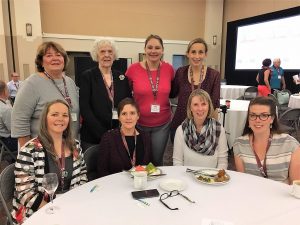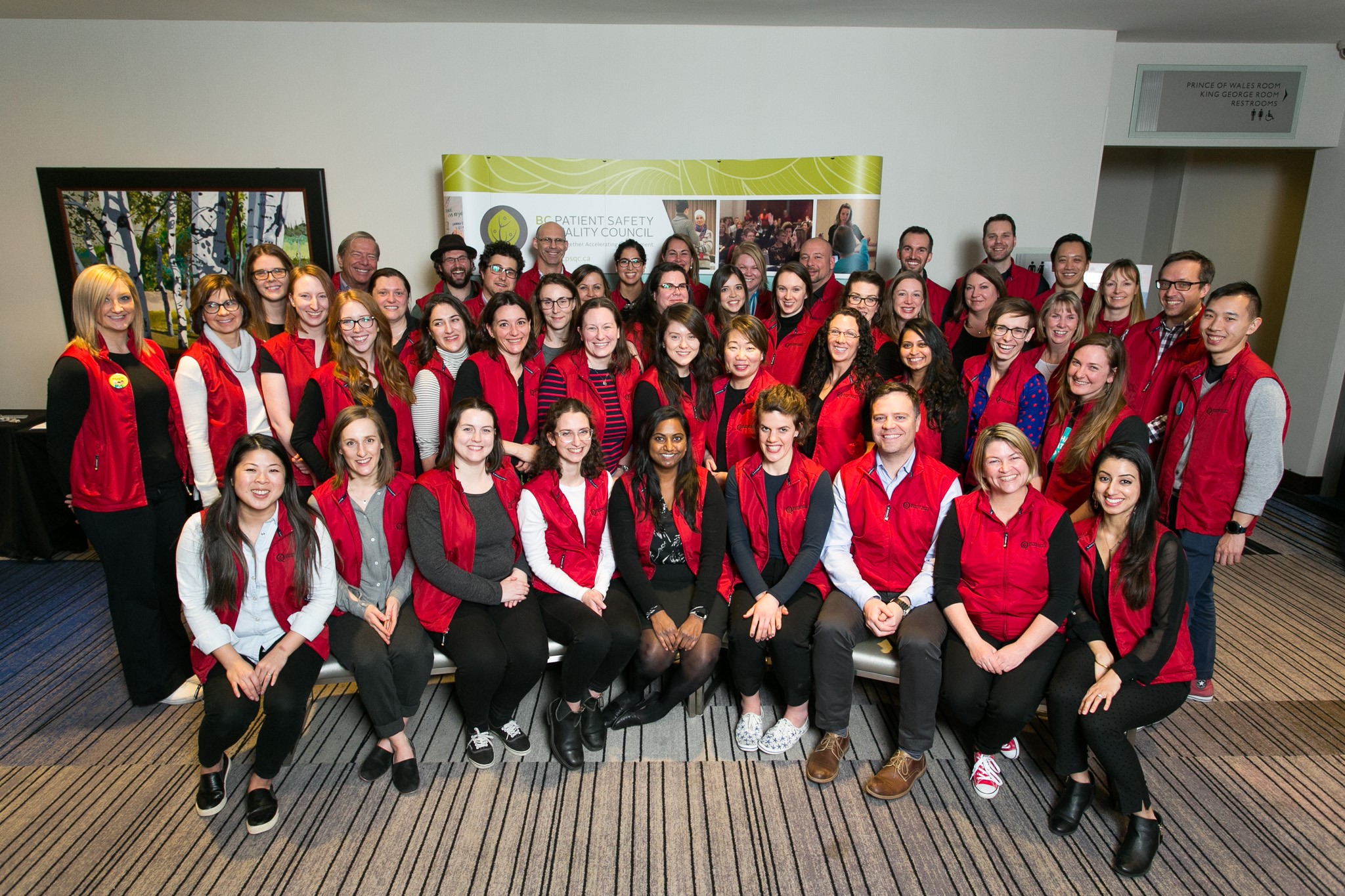Posted • Last updated
Categories: My Experience
[rt_reading_time label=”Reading Time:” postfix=”minutes”]
The International Association for Public Participation (IAP2) recently held their North American conference in Victoria and PVN sponsored three patient partners to attend this great learning opportunity. If you’re unfamiliar with IAP2, this is the organization that created the public engagement spectrum tool that PVN uses for our engagement opportunities.

Bottom row L to R: Edwina, Ana, Carol, Kathryn
The conference welcomed nearly 400 participants from around the world from September 5 – 7, 2018. Sessions were not directly health care-related, but spanned a broad range of topics for anyone looking to engage more authentically with their communities. Apart from the sessions, participants got a chance to meet and network with the other attendees. There was even a conference-wide bike tour around the city!
Engagement Leaders Kira, Carol and Kathryn from BC Patient Safety & Quality Council (which administers PVN) were joined by PVN Patient Partners Edwina Nearhood (sponsored by Northern Health), Alyson Hagan-Johnson (sponsored by Island Health), Margaret Maclennan, Ana Bokstrom, and Tracy Morash, all from different areas of BC. We asked our attendees to share their their highlights from the conference. Though they all agreed that there were great points made in each of the presentations, these were their top takeaways overall, for both patient and health care partners.
-
- Know the Impact of your Story “During one session, a mother shared her experience navigating the health care system with her daughter, who suffers from post-traumatic stress disorder and uses substances. She asked: “Why are my daughter and I not offered the same dignity and respect as the family in the next ER bed battling cancer?” When the daughter had more staff dedicated to her treatment, the outcome was more favourable; her daughter has now been clean for 8 months. These stories ground structural issues in people’s lived experiences and show the profound impact of storytelling. Thank you Nancy for courageously sharing your experiences.” – Edwina
-
- Ask for Help “A lesson I learned was from the session ‘IKEA and Democracy’ by Dave Meslin who has a TED Talk. Though the session was highly entertaining, it came with a serious message. Using Halifax City Hall as an example of an uninviting government organization, Meslin stated, ‘Everyone who works in city hall knows it is city hall.’ Sadly, many of our government organizations make services uninviting and difficult to use. As patient partners, we need to remember to ask for help to navigate health care silos. It’s important for institutions to listen to all voices, rather than just the ones that are loudest.” – Margaret
-
- Name Power Imbalances “Part of what’s necessary is to respect ourselves and our voice. It can be intimidating to advise people who are not used to asking for or receiving input. We are often put in situations where there are power imbalances. This is often also the case when someone is consulting a medical professional, so don’t be afraid to name those imbalances where possible. One of the most valuable things we can do as patient partners is make the medical professionals more sensitive to the feelings of those vulnerable people who come into the medical system.” – Ana
-
- Build genuine relationships “Taking the time to get to know a little bit about your community partners or the participants that you want to work with goes a long way in building the trust that is needed in a positive, respectful partnership. When I was participating in an exercise in one of the workshops it felt more personal to me and like someone was genuinely interested in learning about me. This breaks the ice and helps people open up so that when it is time to get down to the work of engagement and working with community partners, the ice has already been broken. This kind of exercise could be used in all sorts of different engagement work. It could be used between professionals and their volunteers as a way to build a working relationship with the volunteers who are there to give their perspectives, as an interviewing tool and even in daily life in case you need to meet and mingle with strangers.” – Tracy
-
- Put Yourself on the Agenda “If you’re in a meeting format, get yourself put on the agenda. Just because they’ve invited you, don’t assume they will make sure they hear from you. Sometimes we are only there to fulfill a requirement. Edwina kept reminding me “don’t just let them check the box, make sure you’re heard”. If you don’t feel that you can simply speak to the group without context, ask if they can identify in the agenda which items they would like your input on. This way you can prepare in advance.” – Ana
-
- Determine Who Is Missing at the Table and Involve Them “A highlight for me was the field trip to the Songhees Wellness Centre when we learned about the Lekwungen people of Songhees and Esquimalt Nations, and their experiences working with neighbouring communities on governance, economic development, environmental stewardship and other efforts to build a thriving economy and healthy community. This paired well with a session on engagement with communities of colour, recognizing that engagement processes often fail to reach and hear from voices in cultural and marginalized communities. Miranda Eng from Context Research presented a project with Vancouver’s Chinatown community that set out to determine how to make public engagement more inclusive. They asked questions like “who are we not hearing from?”, “Who is (and is not) at the table?”, and “Is the table even in the right place.” – Kira, Engagement Leader.
-
- Put Patient Engagement at the Foundation of the Project “At some point a conference attendee sighed and said “Yeah, but how do we get the ‘higher ups’ to approve the time & budget necessary to create truly authentic relationships?” The panelist responded that we need to stop framing ‘trust’ and ‘relationships’ as mere enabling factors in engagement work, and instead treat them as standalone goals and outcomes of projects (and plan and budget for them accordingly!) That’s an idea that has stuck with me!” – Kira
Thank you to our patient partners and engagement leaders for those great insights! Learn more about IAP2 resources and upcoming events on their website.


